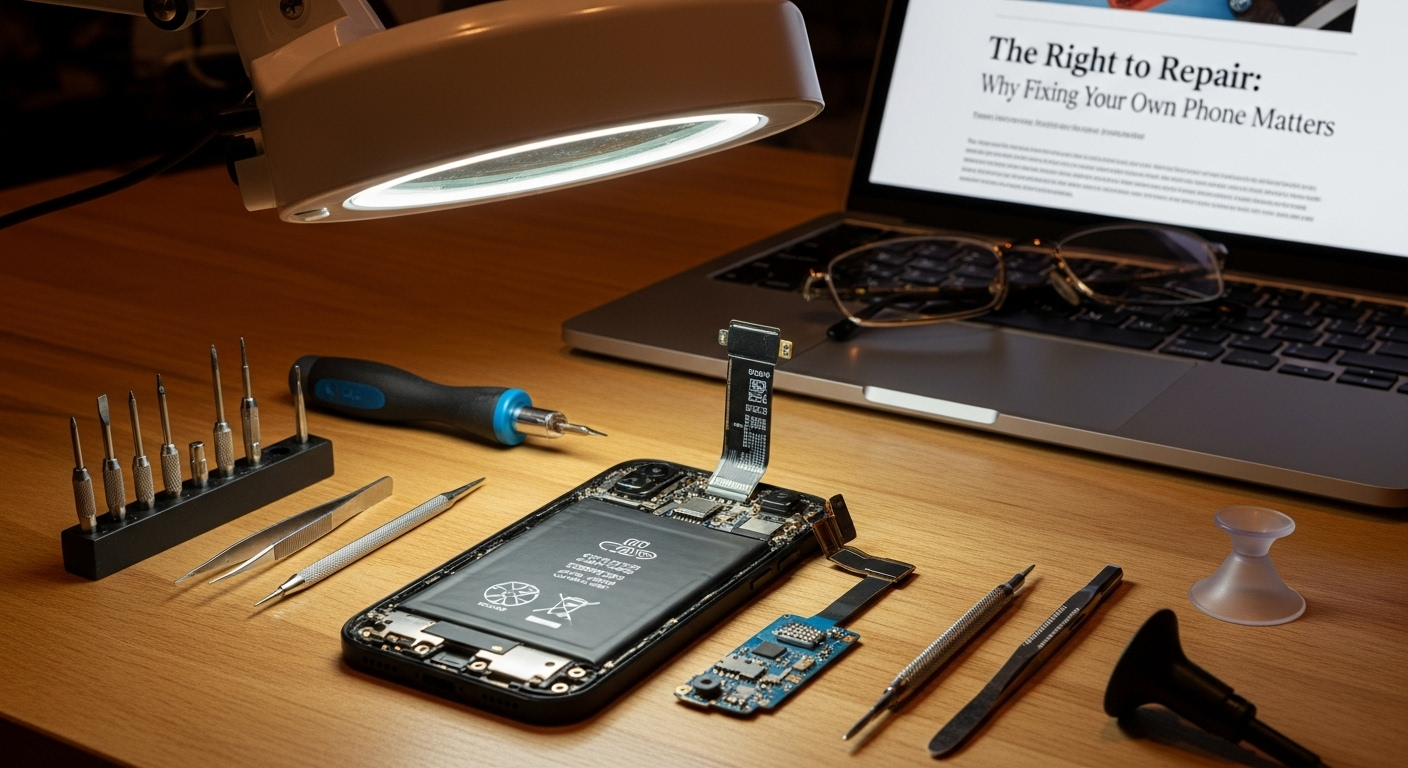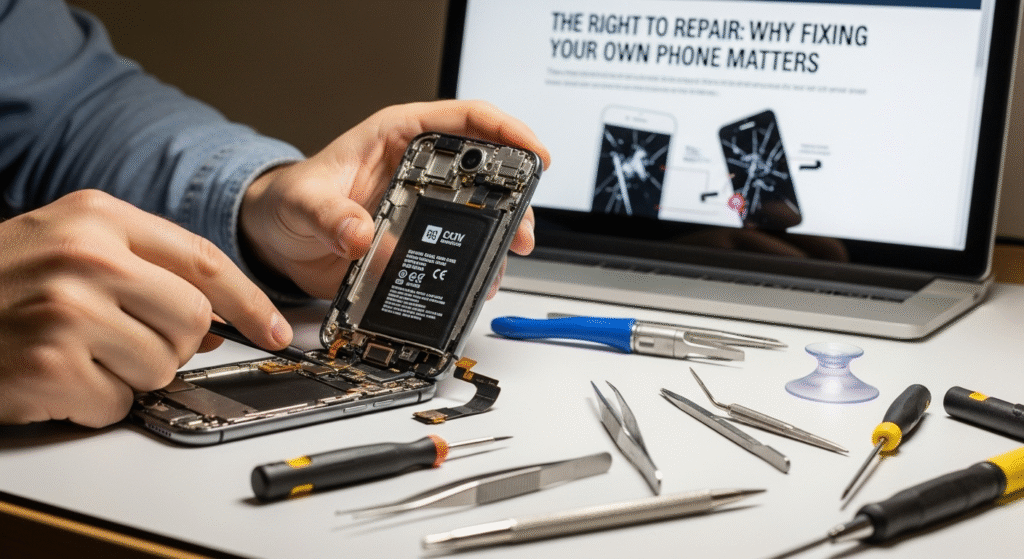Okay, let’s be real. How many of us have a graveyard of old phones in a drawer somewhere? Or maybe a cracked screen we’re just…living with? I know I do. And while upgrading to the latest gadget is tempting (shiny new things!), there’s a growing movement pushing back against the idea of disposable tech: it’s called the Right to Repair. And it’s way more important than you might think.
Forget planned obsolescence for a minute. Think about the sheer waste. Mountains of e-waste, toxic materials leaching into the environment…it’s grim. The Right to Repair is fundamentally about extending the lifespan of our electronics, reducing waste, and, frankly, sticking it to companies that make it ridiculously hard (or impossible!) to fix our own stuff. And that includes our beloved (and essential) phones.
But beyond the environmental angle (which is HUGE), there’s a real personal freedom element at play here. The freedom to choose how we maintain our devices. The freedom to support local repair shops instead of being forced into expensive, manufacturer-controlled ecosystems. Think about it — how often have you been told you need to replace a perfectly functional phone because one tiny component failed and the manufacturer won’t sell the part, or actively locks out third-party repairs?
Why Is Fixing My Phone So Hard? The Manufacturer’s Grip

This is where things get a little… shady. Manufacturers have a vested interest in you buying a new phone, naturally. But the tactics they use to discourage repairs can be downright anti-consumer. Software locks that brick devices if they detect unauthorized repairs? Proprietary screws that require specialized tools? Refusal to provide repair manuals or spare parts to independent shops? It’s all part of a strategy to control the repair market and force you to upgrade.
And it’s not just about iPhones. It’s Android phones, tablets, laptops… pretty much anything with a circuit board these days. The argument they make is often about safety or intellectual property. They say unauthorized repairs can damage devices or compromise security. Okay, maybe sometimes that’s true. But it’s often a smokescreen for maintaining a lucrative monopoly. Let me try to explain this more clearly.
Think about your car. You can take it to the dealer for service, sure. But you also have the option of going to an independent mechanic. You can even (if you’re so inclined) work on it yourself. Why shouldn’t we have the same options with our phones? Crazy Games. But that’s not the world we live in, is it?
The Economic Impact of Right to Repair
It’s not just consumers who are feeling the squeeze. Small, independent repair shops are struggling to compete. They can’t get access to the parts and information they need, putting them at a distinct disadvantage. The Right to Repair legislation aims to level the playing field, giving these businesses a fighting chance. A healthy repair ecosystem creates jobs, supports local economies, and keeps money in our communities. I initially thought the impact was mostly environmental, but the economic aspect is just as compelling.
And, you know, it seems like common sense. Why should a company be able to dictate what you do with something you own, after you’ve bought it? That’s what it boils down to, really. It’s about ownership, control, and the right to choose.
And think about low-income individuals. When a phone breaks, they may not be able to afford a brand-new device. Access to affordable repair options is crucial for bridging the digital divide. It ensures that everyone has access to the technology they need to participate in modern society. Economic Outlook 2024 addresses these concerns in more detail.Wait, there’s something even more interesting here…
The Rise of the Right to Repair Movement
The good news is, the Right to Repair movement is gaining momentum. Lawmakers around the world are starting to take notice. Legislation is being introduced in various states and countries, pushing for greater access to repair information, parts, and tools. It’s a long and complicated battle, but things are moving in the right direction.
Groups like iFixit have been instrumental in advocating for Right to Repair. They provide free repair manuals, sell tools, and raise awareness about the issue. They’re basically the DIY heroes of the tech world. More power to them!
But here’s the thing: legislative change is only one piece of the puzzle. We, as consumers, also have a role to play. We can support businesses that embrace repairability. We can choose products that are designed to be fixed, not replaced. We can demand transparency from manufacturers. And we can make our voices heard by contacting our elected officials and telling them that Right to Repair matters.
FAQ: Your Right to Repair Questions Answered
Why should I care about fixing my own phone?
Beyond the obvious cost savings (repairing is almost always cheaper than replacing), fixing your own phone or supporting independent repair shops reduces e-waste, extends the lifespan of your device, and challenges the manufacturer’s control over the repair process. It’s about taking back ownership and making more sustainable choices.
How do I know if my phone is even fixable?
That’s a fair question! Some phones are notoriously difficult to repair due to their design or the availability of parts. Check out resources like iFixit for repair guides and teardowns. These can give you a sense of whether your particular model is repair-friendly. You can also consult with local repair shops to get their opinion. Sometimes it’s as easy as replacing a screen or battery. Other times… not so much.
What tools do I need to fix my phone?
The specific tools will vary depending on the phone model and the type of repair you’re doing. However, some common tools include a specialized screwdriver set (often with tiny Torx or Pentalobe bits), a spudger (a plastic tool for prying open cases), a suction cup (for removing screens), and tweezers. You can find repair kits online that include all the necessary tools for a specific phone model.
Is it legal for me to fix my own phone?
Generally, yes. However, there are some caveats. Modifying your phone’s software in certain ways could void your warranty (though warranty laws are also evolving). Also, be aware of the potential risks involved in disassembling electronic devices. If you’re not comfortable with the process, it’s best to seek professional help. And remember, safety first! Always disconnect the battery before working on any internal components.
What about the warranty? Will fixing my phone myself void it?
This is a tricky one. Manufacturers often claim that any unauthorized repair will void the warranty. However, in many jurisdictions, this is not entirely true. The Magnuson-Moss Warranty Act in the US, for example, prevents manufacturers from voiding a warranty simply because you used a third-party repair service or part, unless they can prove that the repair caused the damage. It’s always a good idea to check your warranty terms and conditions carefully and to be aware of your rights as a consumer.
And let’s be honest, sometimes the warranty is already expired anyway!
How is The Right to Repair related to phone repair?
The Right to Repair is all about making it easier for consumers and independent repair shops to fix electronic devices, including phones. It challenges manufacturer restrictions on access to parts, tools, and information, promoting competition and extending the lifespan of our devices.
So, there you have it. The Right to Repair: it’s not just about phones. It’s about sustainability, economic fairness, and the fundamental right to control the products we own. It’s a fight worth fighting for.


